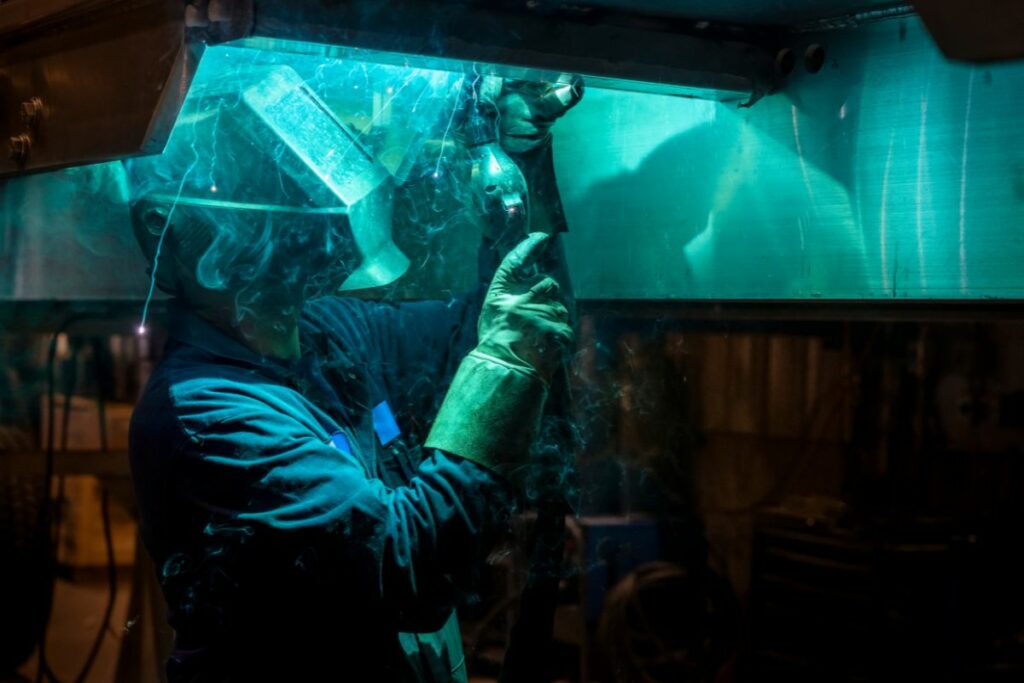
Welding is a versatile trade that encompasses various industries and applications. While all welding jobs come with inherent risks, certain occupations within the field are considered more dangerous due to factors such as challenging environments, exposure to hazardous materials, and stringent safety requirements. In this blog, we will delve into some of the most hazardous welding jobs, exploring the unique risks they pose and the importance of skill, training, and safety protocols in mitigating these dangers.
One of the most challenging and perilous welding jobs is underwater welding. Combining welding skills with diving expertise, underwater welders face the hazards of high water pressure, limited visibility, and potential electrical risks. The need for specialised training, equipment, and stringent safety measures is paramount in this field, given the unique challenges of working in an underwater environment.
Welding in the oil and gas industry involves working with flammable materials, high temperatures, and potentially hazardous chemicals. Welders in this field often operate in confined spaces and face risks such as fire, explosions, and exposure to toxic substances. Strict adherence to safety protocols, effective hazard management, and extensive training are crucial to ensuring the well-being of welders and preventing accidents in these demanding work environments.
Welding structural steel for large-scale projects, such as buildings and bridges, can be physically demanding and pose significant risks. Welders may be required to work at heights or in challenging positions, which increases the likelihood of falls and structural collapses. Adhering to safety guidelines, utilising proper fall protection systems, and conducting thorough risk assessments are essential in minimising hazards and maintaining a safe work environment.
Shipyard welders face a range of risks due to the nature of their work. They operate in confined spaces, encounter toxic fumes and chemicals, and work with potentially flammable materials. Additionally, the welding and repair of ships, offshore platforms, and maritime structures can involve the risk of fires, explosions, and accidents. Rigorous safety training, effective ventilation systems, and meticulous adherence to safety standards are crucial in shipyard welding.
Welding for the aerospace industry demands precision, attention to detail, and strict compliance with quality standards. Welders involved in this field work with specialised materials and must meet rigorous requirements to ensure the safety and integrity of components used in aircraft and spacecraft. Adherence to strict welding procedures, non-destructive testing, and compliance with aerospace regulations are imperative to maintain the highest quality standards in this high-stakes industry.
Welding within nuclear power plants requires exceptional caution and adherence to radiation safety protocols. Welders in this field are responsible for maintaining the integrity of critical components while ensuring the prevention of radioactive material release. Specialised training, strict adherence to safety procedures, and stringent quality control measures are indispensable to minimise radiation exposure risks and guarantee the long-term safety of nuclear power facilities.
Welding high-pressure vessels, such as boilers and tanks, involves working with substances under immense pressure. The potential risks include explosions, leaks, and structural failures. Welders in this field must possess advanced knowledge of pressure vessel design and be proficient in proper welding techniques to ensure the structural integrity of these vessels. Rigorous inspections, compliance with codes and standards, and meticulous welding practices are essential for safety.
Pipeline welding presents unique challenges due to the remote locations, extreme weather conditions, and difficult terrains where welders often work. The construction and maintenance of pipelines require adherence to stringent safety regulations to prevent leaks, ruptures, and potential environmental hazards. Welders must be trained in pipeline-specific techniques and employ robust safety measures, including proper handling of flammable materials and the use of corrosion-resistant materials.
Welding in refinery and petrochemical facilities involves working with highly flammable and toxic materials. Welders must operate in potentially hazardous environments and adhere to strict safety procedures to prevent fires, explosions, and chemical exposure. Specialised training, the use of appropriate personal protective equipment (PPE), continuous monitoring of safety conditions, and regular equipment maintenance are critical to mitigating risks and ensuring the well-being of workers.
Welders involved in mining operations face risks such as working in confined spaces, exposure to hazardous gases, and high temperatures. They may be responsible for maintaining and repairing equipment used in the extraction of minerals, requiring them to work in challenging conditions. Strict adherence to safety protocols, adequate ventilation, and proper training are vital to minimise hazards and safeguard the health and safety of welding professionals in the mining industry.
The welding industry offers a diverse range of career opportunities, each with its own set of risks and challenges. Welders in the aforementioned fields must be equipped with extensive training, specialised knowledge, and a strong commitment to safety. By prioritising skill development, adherence to safety protocols, and ongoing education, welding professionals can navigate the hazards associated with these demanding jobs while contributing to essential industries and ensuring their own well-being.